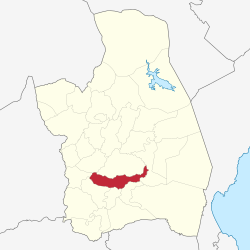This article needs additional citations for verification .(December 2022) |
Santa Rosa | |
|---|---|
| Municipality of Santa Rosa | |
 Downtown | |
 Map of Nueva Ecija with Santa Rosa highlighted | |
Location within the Philippines | |
| Coordinates: 15°25′26″N120°56′20″E / 15.4239°N 120.9389°E | |
| Country | Philippines |
| Region | Central Luzon |
| Province | Nueva Ecija |
| District | 3rd district |
| Founded | August 1, 1878 |
| Annexation to Cabanatuan | October 8, 1903 |
| Chartered | August 7, 1907 |
| Barangays | 33 (see Barangays) |
| Government | |
| • Type | Sangguniang Bayan |
| • Mayor | Christopher Flores Aguilar |
| • Vice Mayor | Richard D. Dimacali |
| • Representative | Julius Cesar V. Vergara |
| • Municipal Council | Members |
| • Electorate | 54,240 voters (2025) |
| Area | |
• Total | 147.15 km2 (56.81 sq mi) |
| Elevation | 28 m (92 ft) |
| Population (2024 census) [3] | |
• Total | 80,258 |
| • Density | 550/km2 (1,400/sq mi) |
| • Households | 18,801 |
| Economy | |
| • Income class | 1st municipal income class |
| • Poverty incidence | 13.25% (2015) [4] |
| • Revenue | ₱ 347.2 million (2022) |
| • Assets | ₱ 897.4 million (2022) |
| • Expenditure | ₱ 70.58 million (2022) |
| • Liabilities | ₱ 286 million (2022) |
| Service provider | |
| • Electricity | Nueva Ecija 2 Area 2 Electric Cooperative (NEECO 2 A2) |
| Time zone | UTC+8 (PST) |
| ZIP code | 3101 |
| PSGC | |
| IDD : area code | +63 (0)44 |
| Native languages | Tagalog Ilocano |
Santa Rosa, officially the Municipality of Santa Rosa (Tagalog: Bayan ng Santa Rosa) is a municipality in the province of Nueva Ecija, Philippines. According to the 2020 census, it has a population of 75,649 people. [5]
Contents
- History
- Geography
- Barangays
- Climate
- Demographics
- Economy
- Government
- Local government
- Tourism
- St. Rose of Lima Parish Church
- 1946 Holy Cross College and Chapel
- San Mariano Chapel or "The Miraculous Round Chapel of San Mariano"
- 1890 Ancestral House of Brgy. San Gregorio, Santa Rosa
- Education
- Primary and elementary schools
- Secondary schools
- Higher education institution
- Notable people
- Gallery
- Sister cities
- References
- External links













